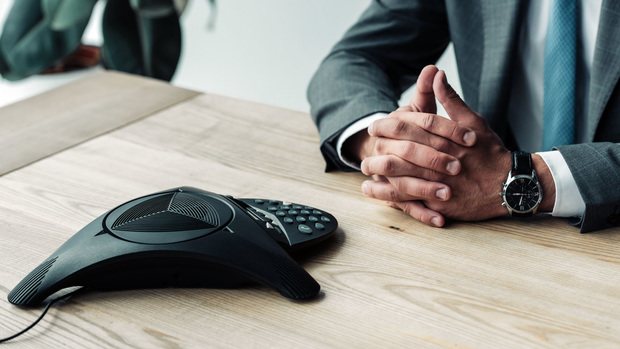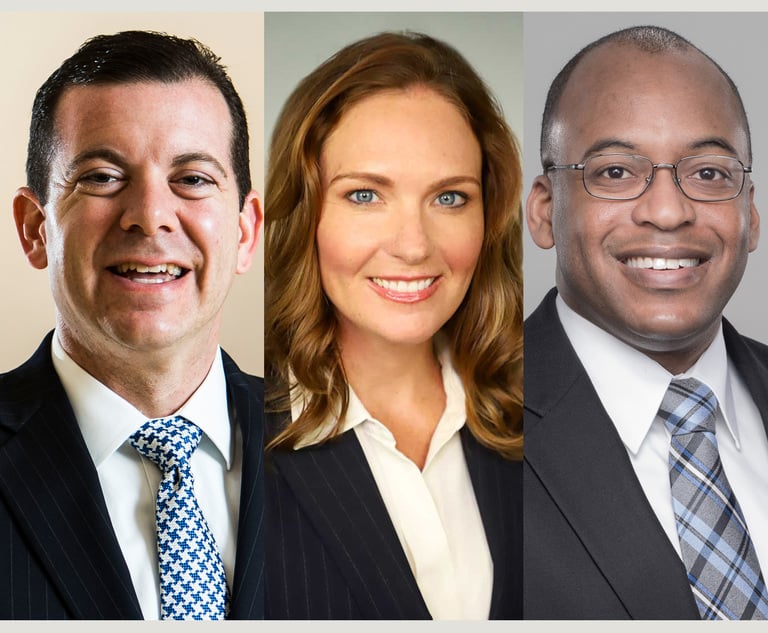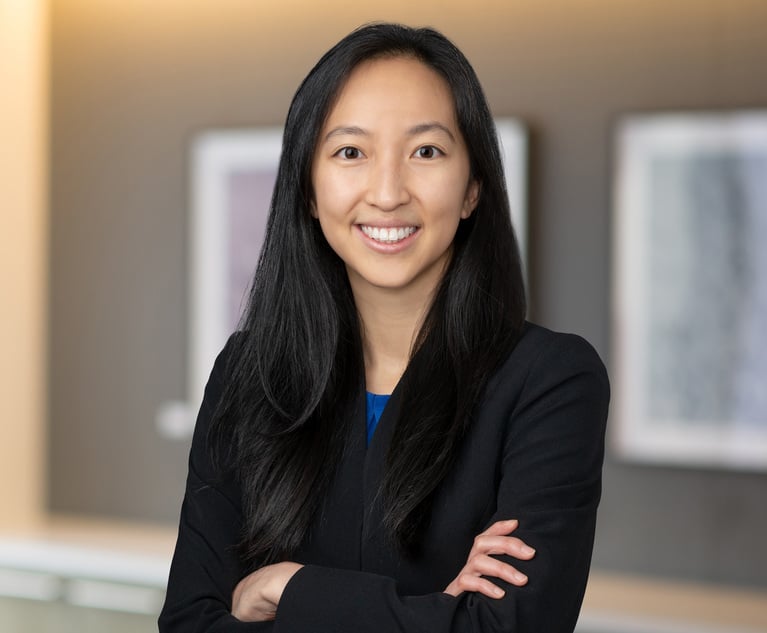Some Tips From the Trenches Ahead of the Supreme Court's First Telephonic Arguments
Morrison & Foerster's Joseph Palmore recently argued his first telephonic oral argument before the highest court in Massachusetts. He shares his thoughts on what makes a successful session.
April 16, 2020 at 11:29 AM
6 minute read
The original version of this story was published on National Law Journal

The U.S. Supreme Court announced this week that it will hold oral arguments in May by teleconference and that "[d]etails will be shared as they become available." Those details matter—they'll help determine whether the Court's pandemic-forced innovation will succeed.
I argued an appeal by phone last week. That gives me exactly one more such argument than many appellate lawyers—who, like me until very recently, have done zero. That doesn't make me an expert, but my experience has led to thoughts on how the Supreme Court can make the best of this format.
First a bit of background. I argued before the Massachusetts Supreme Judicial Court, the commonwealth's highest court. Like the U.S. Supreme Court, it's hearing arguments by phone. And the Massachusetts court has seven justices, which makes it similar in size to the U.S. Supreme Court. All of this means the Supreme Judicial Court is something of a test case for the justices and court officers now planning the Supreme Court's phone arguments.
The Supreme Judicial Court follows this standard format for its phone arguments:
First, each advocate gets three minutes at the start of their time to speak without interruption.
Second, justices are recognized in descending order of seniority by the chief justice to ask their questions. The chief justice goes last. After one full round, the chief asks the justices if they have any additional questions.
Third, while each side still has a formal time limit of 15 minutes, no buzzer or chime marks it. Allowing each justice to ask questions in turn (with a second round when necessary) means that many of the arguments have gone over time.
Fourth, the argument audio is live-streamed to the general public.
The Clerk for the Commonwealth Fran Kenneally and his excellent team clearly communicated this format to advocates in advance. The chief justice then reiterated it at the start of each argument.
The U.S. Supreme Court's prior practices and already-announced plans mirror some of this. The Supreme Court recently began allowing advocates two minutes of uninterrupted time to open their arguments. And the high court has already announced it will livestream the audio of its telephone arguments. A first for the court, livestreaming is a welcome move in favor of public access to its work.
The main challenge of telephone arguments at the Supreme Court will be justices' questioning. A typical Supreme Court argument can be like an 8-on-1 game of ping-pong, in which advocates answer questions in rapid succession from different, often-interrupting Justices. (It's 8-on-1 instead of 9-on-1 because Justice Clarence Thomas is famously silent during oral argument.)
That free-for-all, rapid-fire mode of argument may be ill-suited to a teleconference. Some federal courts of appeals, like the Federal Circuit, have allowed judges to ask questions in the ordinary, unstructured way during phone arguments without much problem. But what works for a three-judge panel may be unwieldy for a nine-Justice Supreme Court.
Anyone who has participated in a large conference call knows how common it is for people to talk over each other, awkwardly pause and then do it again. The slight time lag on the phone and the inability to see visual cues that someone is about to speak can make for a frustrating conversation. Those difficulties are compounded when multiple people are eagerly trying to interject or disagree—people like the justices at a typical argument.
Another problem with attempting the court's traditional, freewheeling approach on the phone would be identifying which Justice is speaking. Veteran court observers may be able to guess a questioning Justice by voice, but first-time advocates and members of the public may not.
One solution would be to follow the Supreme Judicial Court's approach of having justices ask questions in seniority order. That would avoid cross-talk and limit interruptions. It would also allow participants and listeners to identify a justice who speaks because the chief justice would have called on them. But that format would not allow Justices to easily follow up on other Justices' questions, as often happens in live arguments.
If the court prefers a less-rigid approach, it could use a hybrid system. Justices could notify the chief justice by email that they have a question, allowing him to call on each in turn. The chief could use this air traffic-control power to spread questions equitably, identify each speaking justice by name and keep the arguments roughly within their assigned time limits.
On the other side of the equation are the advocates who will argue by phone in May. From the attorney's perspective, what is different about presenting argument by phone? Not much actually. Whether in person, over the phone or on video, the oral advocate's goals are the same: Make the important affirmative points, directly answer questions and know the record and relevant law cold.
To prepare for my phone argument, I had the same kind of moot courts as always. I did the "in-role" portion telephonically to simulate the coming argument, followed by a debrief session on video. I also made the same kind of argument outline I always do. But, just as I never look at an outline during an in-person argument, I did not do so during the phone argument, preferring natural conversation to reading.
A final word on technology and the need for testing. During my argument, audible static could be heard on my line when I spoke, likely due to storms moving through Washington, D.C., at the time. The high court should consider a pre-argument audio check, in which advocates and justices can call in, test sound quality and ensure a good connection.
I commend the court for proceeding with oral arguments. With careful planning and communication, its telephone sessions will be successful. And they will provide the public valuable access to a part of their government that has shown admirable flexibility in proceeding with its business in these difficult times.
Joseph Palmore is co-chair of the appellate and Supreme Court practice group at Morrison & Foerster. He has argued 12 cases before the U.S. Supreme Court, including two this term.
This content has been archived. It is available through our partners, LexisNexis® and Bloomberg Law.
To view this content, please continue to their sites.
Not a Lexis Subscriber?
Subscribe Now
Not a Bloomberg Law Subscriber?
Subscribe Now
NOT FOR REPRINT
© 2025 ALM Global, LLC, All Rights Reserved. Request academic re-use from www.copyright.com. All other uses, submit a request to [email protected]. For more information visit Asset & Logo Licensing.
You Might Like
View All
With DEI Rollbacks, Employment Lawyers See Potential For Targeting Corporate Commitment to Equality
7 minute read
MoFo Associate Sees a Familiar Face During Her First Appellate Argument: Justice Breyer

Amid the Tragedy of the L.A. Fires, a Lesson on the Value of Good Neighbors
Law Firms Mentioned
Trending Stories
- 1The Rise and Risks of Merchant Cash Advance Debt Relief Companies
- 2Ill. Class Action Claims Cannabis Companies Sell Products with Excessive THC Content
- 3Suboxone MDL Mostly Survives Initial Preemption Challenge
- 4Paul Hastings Hires Music Industry Practice Chair From Willkie in Los Angeles
- 5Global Software Firm Trying to Jump-Start Growth Hands CLO Post to 3-Time Legal Chief
Who Got The Work
J. Brugh Lower of Gibbons has entered an appearance for industrial equipment supplier Devco Corporation in a pending trademark infringement lawsuit. The suit, accusing the defendant of selling knock-off Graco products, was filed Dec. 18 in New Jersey District Court by Rivkin Radler on behalf of Graco Inc. and Graco Minnesota. The case, assigned to U.S. District Judge Zahid N. Quraishi, is 3:24-cv-11294, Graco Inc. et al v. Devco Corporation.
Who Got The Work
Rebecca Maller-Stein and Kent A. Yalowitz of Arnold & Porter Kaye Scholer have entered their appearances for Hanaco Venture Capital and its executives, Lior Prosor and David Frankel, in a pending securities lawsuit. The action, filed on Dec. 24 in New York Southern District Court by Zell, Aron & Co. on behalf of Goldeneye Advisors, accuses the defendants of negligently and fraudulently managing the plaintiff's $1 million investment. The case, assigned to U.S. District Judge Vernon S. Broderick, is 1:24-cv-09918, Goldeneye Advisors, LLC v. Hanaco Venture Capital, Ltd. et al.
Who Got The Work
Attorneys from A&O Shearman has stepped in as defense counsel for Toronto-Dominion Bank and other defendants in a pending securities class action. The suit, filed Dec. 11 in New York Southern District Court by Bleichmar Fonti & Auld, accuses the defendants of concealing the bank's 'pervasive' deficiencies in regards to its compliance with the Bank Secrecy Act and the quality of its anti-money laundering controls. The case, assigned to U.S. District Judge Arun Subramanian, is 1:24-cv-09445, Gonzalez v. The Toronto-Dominion Bank et al.
Who Got The Work
Crown Castle International, a Pennsylvania company providing shared communications infrastructure, has turned to Luke D. Wolf of Gordon Rees Scully Mansukhani to fend off a pending breach-of-contract lawsuit. The court action, filed Nov. 25 in Michigan Eastern District Court by Hooper Hathaway PC on behalf of The Town Residences LLC, accuses Crown Castle of failing to transfer approximately $30,000 in utility payments from T-Mobile in breach of a roof-top lease and assignment agreement. The case, assigned to U.S. District Judge Susan K. Declercq, is 2:24-cv-13131, The Town Residences LLC v. T-Mobile US, Inc. et al.
Who Got The Work
Wilfred P. Coronato and Daniel M. Schwartz of McCarter & English have stepped in as defense counsel to Electrolux Home Products Inc. in a pending product liability lawsuit. The court action, filed Nov. 26 in New York Eastern District Court by Poulos Lopiccolo PC and Nagel Rice LLP on behalf of David Stern, alleges that the defendant's refrigerators’ drawers and shelving repeatedly break and fall apart within months after purchase. The case, assigned to U.S. District Judge Joan M. Azrack, is 2:24-cv-08204, Stern v. Electrolux Home Products, Inc.
Featured Firms
Law Offices of Gary Martin Hays & Associates, P.C.
(470) 294-1674
Law Offices of Mark E. Salomone
(857) 444-6468
Smith & Hassler
(713) 739-1250







